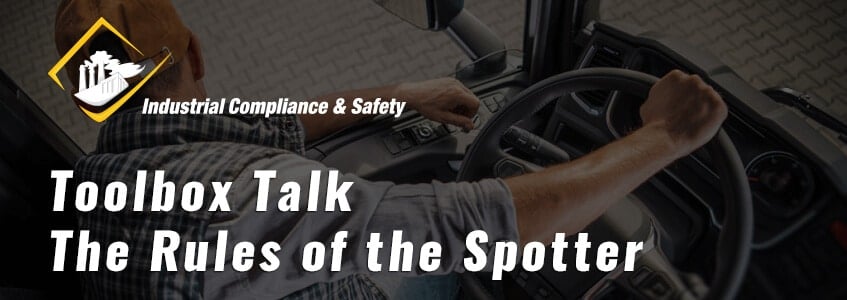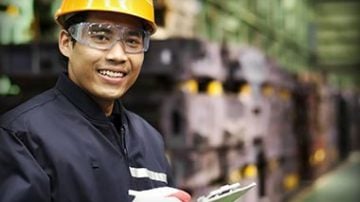Date: ____________________________________
Supervisor: _______________________________
Company Name: _____________________________
Job Name: ______________________________
Most construction sites rely on a wide variety of vehicles and heavy equipment, from semi-trucks to bulldozers. These large vehicles require skilled, qualified drivers. However, even the most skilled driver could benefit from the assistance of a heavy equipment spotter. Large vehicles have many blind spots, and it is always helpful to have a person on the outside to safely scan and guide the driver - especially during difficult tasks such as backing up. With this Toolbox Talk, we will review forklift spotter responsibilities within a construction site, and what they should remember when in this position.
Guidelines for Discussion
If you are qualified to operate heavy machinery or large vehicles, you know how tricky it can be to see your surroundings. Bulldozers, delivery trucks, cranes, etc. can be rife with blind spots, and these can prove especially dangerous during tasks that require acute maneuvering. For these reasons, it is best for everyone’s safety to have a designated construction spotter onsite. You can have one spotter who assists every driver for all vehicles and tasks, or you can choose different workers to take on this role depending on the circumstance. Regardless of what works best for your crew, a heavy equipment spotter should understand the following duties:
- Look out for yourself.
- Look out for your coworkers. Know where everyone is generally located before the vehicle begins moving.
- Check the exterior of the vehicle for anything that may be problematic during movement.
- Make sure the vehicle is not damaged during movement.
- Make sure the worksite, surrounding equipment, and project materials are not damaged.
- Give clear and understandable signals. If necessary, communicate with the driver beforehand to ensure that you both agree upon the meaning of a signal.
- Never pass out of the driver’s view without stopping the vehicle.
- Do not move into the path of the vehicle.
- If you must go directly behind a vehicle, keep one hand on it so that you can immediately sense any movement of the vehicle.
- Always signal on the driver’s side.
- Always watch where you are walking, and communicate with your coworkers if they walk near the moving vehicle.
If you are not the designated construction spotter, do not interrupt the spotter while he/she is in this position. Additionally, if you are not the designated spotter but you notice a problem that the spotter and driver have missed, communicate it immediately.
If you are the driver, pay attention to your spotter. Communicate if his signals are unclear or if he/she is difficult to see from your window.
Additional Discussion Notes:
Remember, it is the responsibility of the heavy equipment spotter to ensure that the vehicles of the construction site function without injury or property damage. This is a big responsibility, and no one should take it lightly.
After this Toolbox Talk, briefly discuss when this role is necessary (for your particular company), and assign a spotter/spotters for your construction site(s). Acquiring and training these professionals is the key to improving not only the efficiency of your work but also the safety of your entire team.
Safety Recommendations: _____________________
Job Specific Topics: ___________________________
Attendees:
____________________________________
____________________________________
____________________________________
____________________________________
____________________________________
____________________________________
____________________________________
____________________________________
____________________________________
____________________________________
____________________________________
____________________________________
____________________________________
____________________________________
____________________________________
____________________________________
____________________________________
____________________________________
____________________________________
____________________________________
____________________________________
____________________________________
Disclaimer
The information contained within this document (both the online and downloadable version) is provided for informational purposes only. Nobody shall take this as a comprehensive or exhaustive resource on this topic. This material is believed to be accurate, however, the information has been compiled from multiple sources, and so Industrial Compliance & Safety assumes no responsibility for the accuracy of this information. We encourage you to consult experts about this specific Toolbox Talk to ensure you are compliant with any and all safety regulations and processes. In no event does the content of this document supersede any applicable local, state, or federal statutes or regulations.





